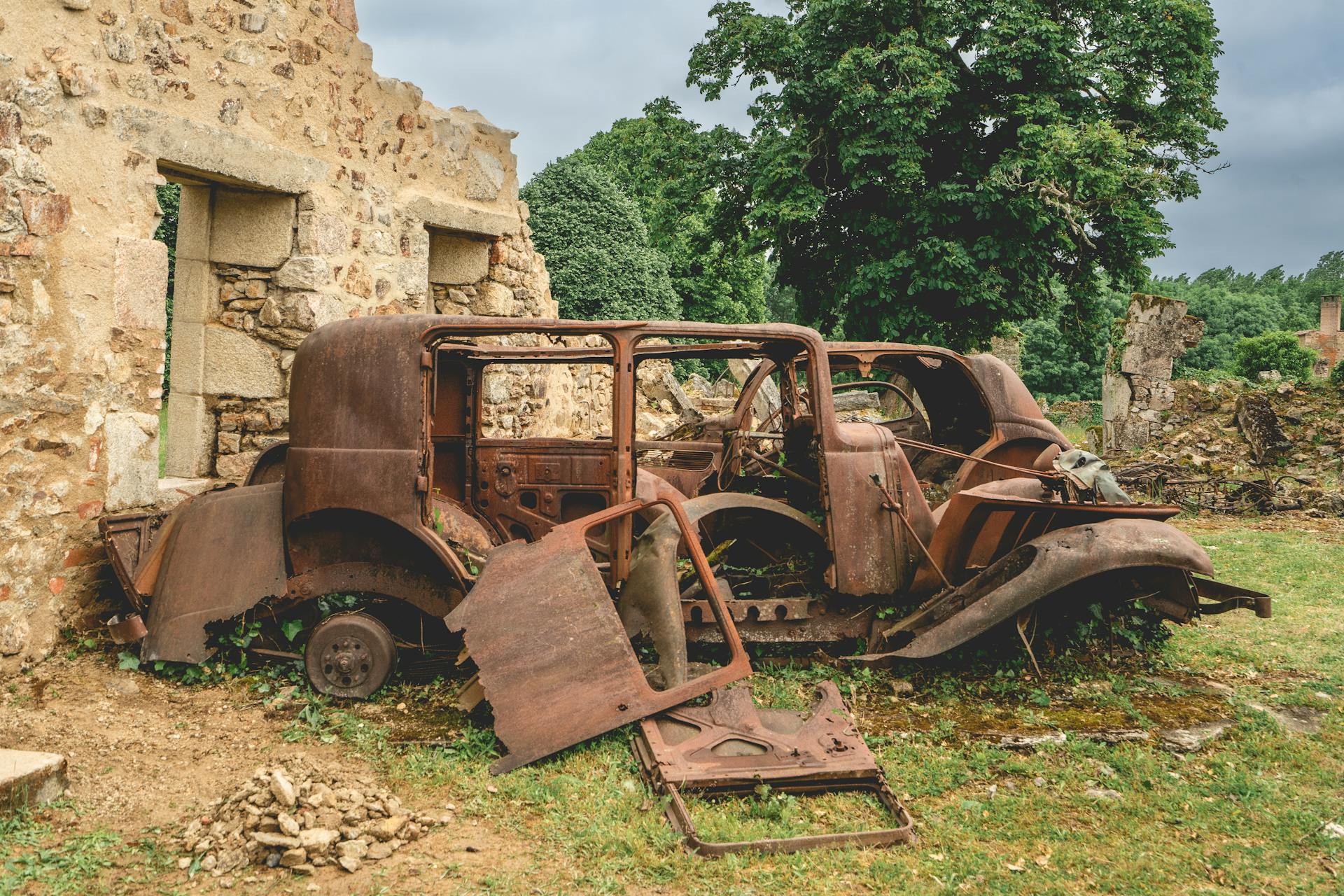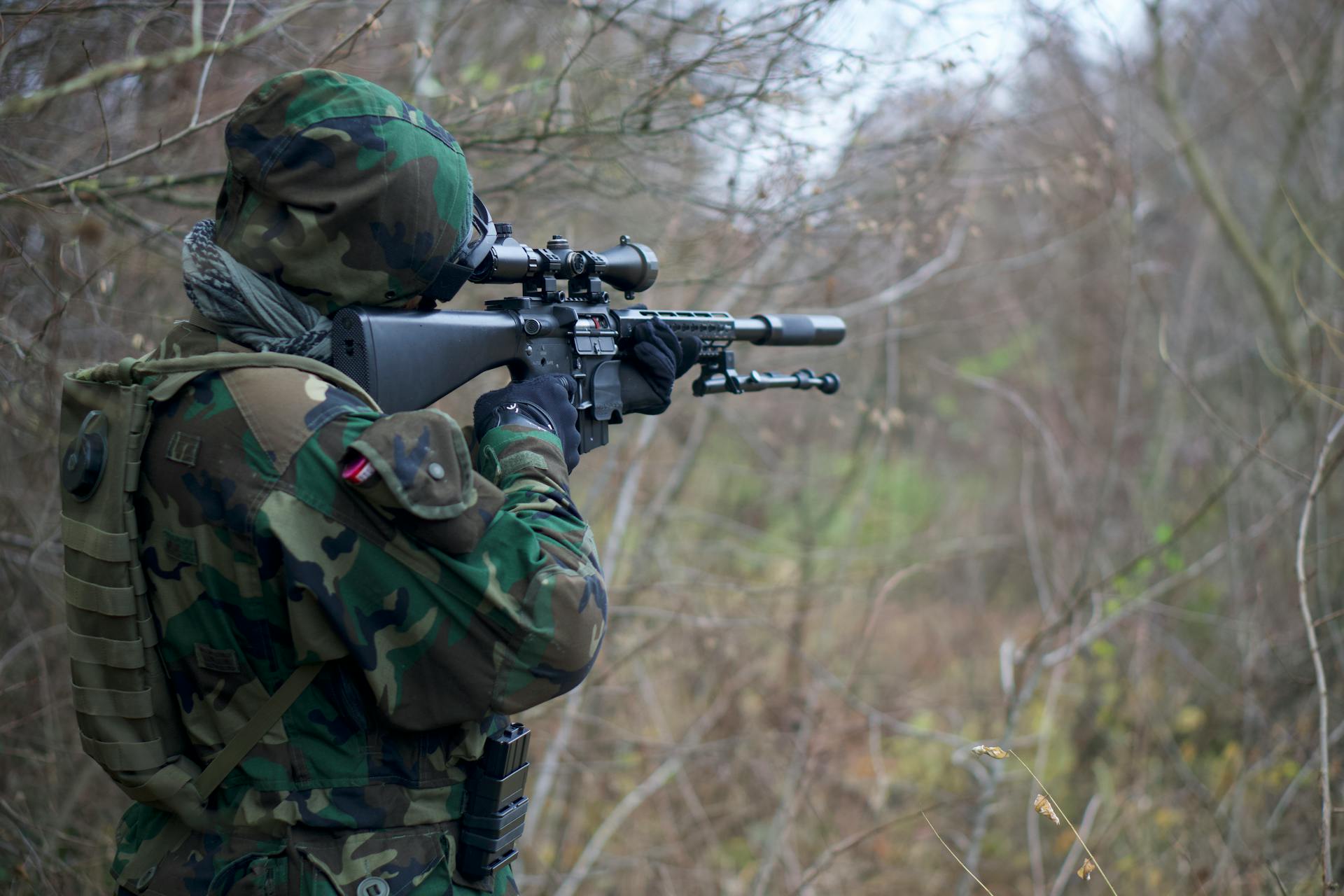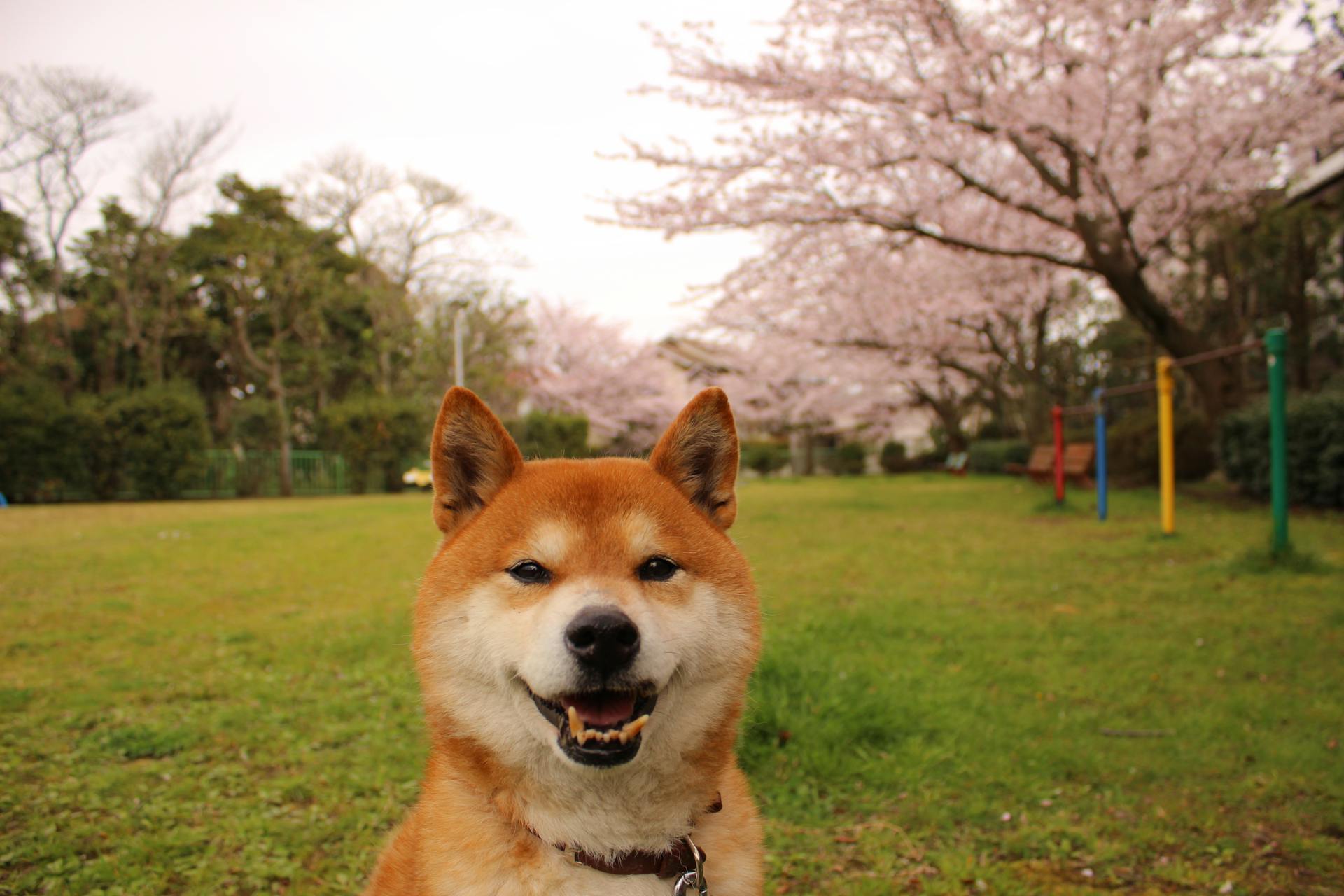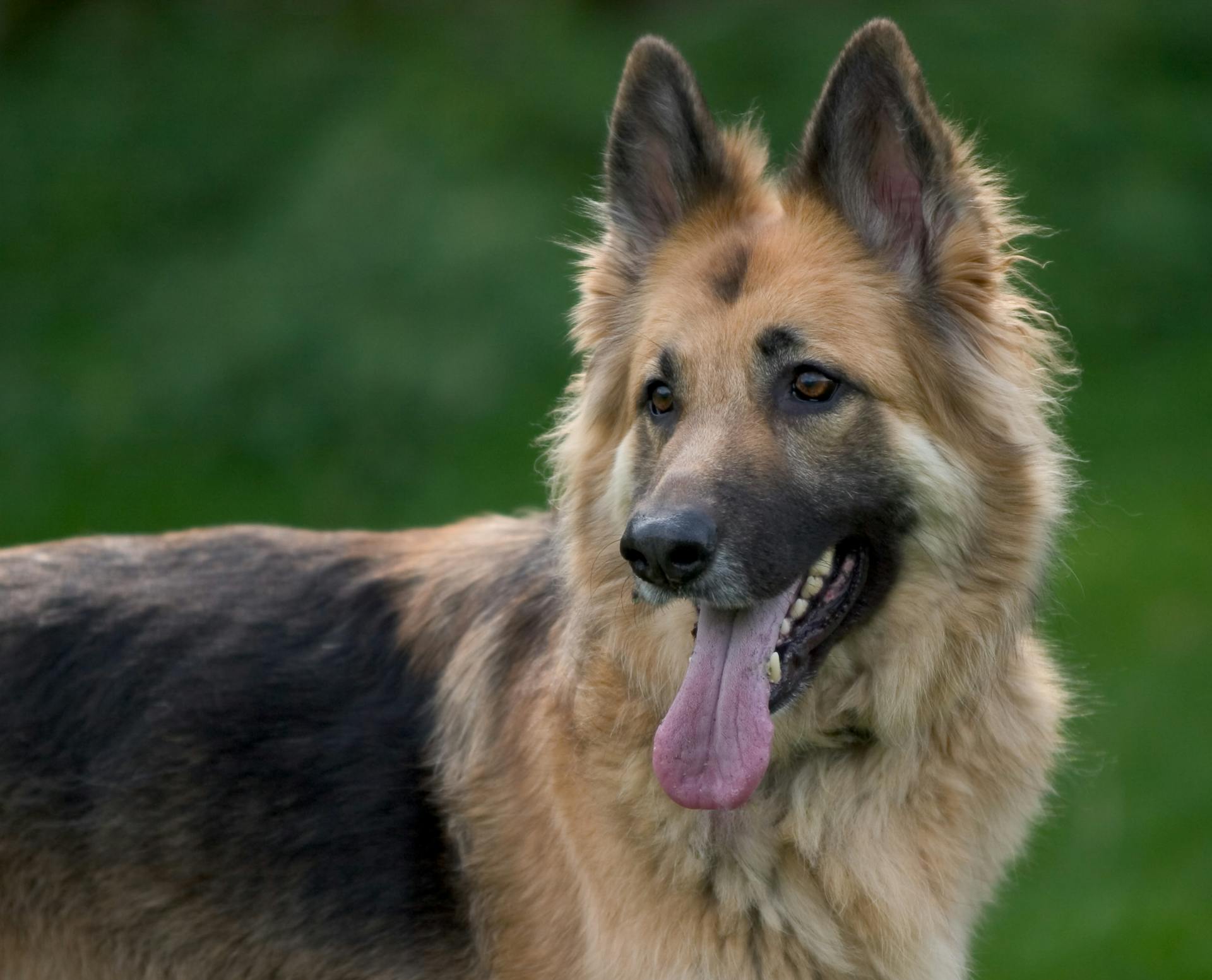
During World War 2, military dogs played a crucial role in the war effort.
They were used for sentry duty, patrolling, and locating wounded soldiers.
These dogs were trained to detect explosives and sniff out enemy troops.
Their keen sense of smell helped locate enemy soldiers, saving countless lives.
The most famous military dog of World War 2 was a German Shepherd named Chips, who served with the US Marine Corps.
Chips was awarded the Purple Heart for his bravery in combat.
Curious to learn more? Check out: Fostering Military Dogs
Military Dog Breeds
The British Royal Army Veterinary Corps preferred the German Shepherd, but also used Dobermans, Airedales, and Rottweilers for their war dogs. These breeds were capable of being quiet, dependable, and rugged.
The German Shepherd is by far the most common dog in military service, highly intelligent, strong, agile, and easy to train. They can adapt to almost any climatic condition.
The Belgian Malinois is valued for its exceptional quick reaction time, fearless dedication to duty, and strong protective instinct. They are also highly regarded for their intelligence and loyalty.
Dutch Shepherds are known for their versatility, intelligence, and being highly trainable, making them useful in many military duties. They are also loving, energetic, lively, athletic, and protective.
Doberman Pinschers were the preferred military dog and nicknamed the 'Devil Dog of the Marines' in the Marine Corps for their ability to deliver ammunition, messages, and medical supplies. They are also highly energetic and have a strong protective instinct.
Smoky, a Yorkshire Terrier, became a real soldier and learned over 200 hand signals and commands. She survived over 150 Japanese Kamikaze attacks and flew 12 rescue and recognizance missions.
The Staffordshire Bull Terrier is an asset in the military because of its characteristics of being energetic, protective, adaptable to military operations, and trainable. They are also known for their loyalty and loving nature.
Airedale Terriers were used as communication dogs and carried messages back and forth across the battlefield during World War I. They were trained to work with two handlers and were renowned for their ability to stay low and out of sight.
Giant Schnauzers serve in the armed forces using their sniffing skills as explosive detector dogs. They are also excellent guard dogs and are often on patrol.
Worth a look: Retired Military Dogs
WWII Military Dogs
Military dogs played a crucial role in World War II, serving as messengers, paratroopers, and medical assistants. They were used in various capacities, from delivering vital supplies to locating and rescuing downed pilots.
The Germans were particularly skilled at training their messenger dogs, using a 10-to-1 mixture of water and a molasses-like substance smelling like root beer to create a scent trail for them to follow. British and American forces also used messenger dogs, with two handlers working together to ensure the dog's safe return.
In the Italian Campaign, war dogs were even used to help lay wire communications by pulling wire up slopes too difficult for men to climb. This highlights the versatility and resourcefulness of military dogs during wartime.
Here's a list of some of the notable military dog roles in WWII:
- Messenger dogs
- Paratroopers (e.g. the first active duty airborne dog, a British collie named Rob)
- Medical dogs (trained to locate and rescue wounded soldiers)
- Draft dogs (used to pull carts or sleds in rough terrain)
U.S. Army Canines in WWII
The U.S. Army had a special unit called the K-9 Corps, which was responsible for training and deploying war dogs during World War II.
The training programs for U.S. Army war dogs were typically six to eight weeks long, but could last up to 12 weeks for dogs performing more specialized missions.
The Army produced a manual on the subject, Technical Manual; TM 10-396, War Dogs, 1 July 1943.
Dog handlers were also specially selected, with a solid prerequisite being men who were both friendly and sympathetic to dogs.
The U.S. Army used dogs for various tasks, including sentry duty, messenger work, and medical assistance.
In the Battle of the Bulge, the U.S. Army used sled dogs to locate and rescue wounded soldiers in the harsh winter conditions.
The first active duty airborne dog was a British collie named Rob, who made 20 combat jumps while serving with the British Special Air Service commandos in North Africa.
The U.S. Army also used dogs as messengers, with a maximum range of about eight miles, usually less.
A famous Wehrmacht German shepherd named Caesar was the record setter, delivering a message over 10.5 miles in 32 minutes.
The U.S. Army used dogs for communication in areas where laying wire was difficult, such as in the mountainous terrain of the Italian Campaign.
Consider reading: What Are Service Dogs for
The German Shepherd breed was particularly popular for military use due to its intelligence, loyalty, and endurance.
Here is a brief overview of the breeds used by the U.S. Army in WWII:
The U.S. Army Canines in WWII played a vital role in supporting the war effort, and their contributions were invaluable.
Soviet Dog Mines Against German Tanks
The Soviet Union's use of dog mines against German tanks was a desperate measure during Operation Barbarossa.
In early 1942, the Soviets were hard-pressed on the Eastern Front, having lost many tanks and antitank weapons in 1941.
Dogs were trained to run under enemy tanks with anti-tank mines attached to their backs.
A canvas body harness was fitted to the dogs, with a wooden box or packets of high explosive attached, weighing as much as 25 pounds.
The explosives were triggered by a wooden dowel, known as a tilt rod detonator, which protruded upward from the dog's back.
The idea was to destroy the tank with a blast to the thin bottom armor.
However, training the dogs proved to be a challenge.
The dogs were fed beneath Soviet tanks to train them, but this didn't prepare them for the German tanks, which had different smells, sounds, and sights.
In the chaos of war, the dogs often became confused or panicked, running under friendly tanks as well as enemy ones.
The German Army soon learned of the Hundminen and ordered soldiers to shoot all dogs on sight.
Despite a few successes, the use of dog mines was short-lived.
Curious to learn more? Check out: Service German Shepherds
Canine Vet Honors
Stubby, a canine vet, led US troops in a pass and review parade after returning home from service.
He visited with President Woodrow Wilson and made two visits to the White House, meeting Presidents Warren Harding and Calvin Coolidge.
Stubby followed J. Robert Conroy to Georgetown University, where he became a mascot for the Hoyas.
Today, Stubby's taxidermied remains reside at the Smithsonian Institute National Museum of American History, Armed Forces Collections, in Washington, DC.
He has been honored numerous times, including having a brick in the Walk of Honor World War I monument in Kansas City.
Top Breeds
The British Royal Army Veterinary Corps preferred the Alsatian, which is another name for the German shepherd, but also used dobermans, airedales, and rottweilers. They found that high pedigrees were less important than originally thought, and mongrels with Alsatian blood and even some outright mutts could learn and perform quite well.
The U.S. Marine Corps in the Pacific Theater favored the doberman pinscher, which became the official dog of the USMC and earned the nickname "Devil Dogs." They were known for their ability to learn and perform well.
The U.S. Army's war dogs initially considered over thirty breeds suitable for military service, but by 1944, the number of preferred breeds had been reduced to seven, including German shepherds, Belgian sheep dogs, and doberman pinschers.
Broaden your view: Specific Tasks for Service Dogs
Labrador Retriever
Labrador Retrievers are highly valued for their exceptional skills in detection tasks. They are retrievers and hunters by nature, making them invaluable in detection work.
Their keen sense of smell allows them to detect 17 different homemade explosive scents. This makes them a popular choice as bomb detection dogs.
A fresh viewpoint: Allergen Detection Service Dogs
Labrador Retrievers are easier to control remotely than German Shepherds, using whistles and arm signals. This is a significant advantage in military work.
In combat tracking, Labrador Retrievers excelled in the Vietnam War, working with four or five combat troops to rescue injured troops and find downed airmen. Many American service members owe their lives to the keen noses of those Labrador Retrievers.
Labrador Retrievers work well off-leash and can ease the stress of military work. This flexibility is a significant asset in high-pressure situations.
A unique perspective: Dog Work
Yorkshire Terrier
Yorkshire Terriers are known for their loyalty, a trait that was demonstrated by Smoky, a Yorkshire Terrier who served in the army during World War II.
Smoky was trained by her owner, William Wynne, who had experience training dogs in his civilian life. She learned over 200 hand signals and commands and was even taught to eat C-rations.
This brave little dog survived over 150 Japanese Kamikaze attacks in New Guinea and flew 12 rescue and reconnaissance missions.
Curious to learn more? Check out: Yorkshire Terrier Service Dog
Boxer
Boxers are brave dogs, known for their energetic and smart nature. They're also great with kids and fun to be around.
Boxers are highly trainable, which makes them a great breed for first-time dog owners. They're also muscular and agile, making them well-suited for active families.
Boxers are protective of their families, but they're not generally aggressive dogs. They're a loyal breed that thrives on attention and interaction.
Boxers are strong dogs that can carry packs and gear across the battlefield, as seen during World War II. They're also known for their ability to jump out of planes with Allied forces, wearing parachutes like Vittles.
For your interest: Do Boxers Make Good Service Dogs
Frequently Asked Questions
Why are army soldiers called Doggies?
Army soldiers are called "Doggies" due to their resemblance to dogs, sleeping in pup tents and being summoned like pets with a whistle. This nickname originated from the hardships and challenges of military life, often referred to as a "dog's life
What do marines call doggies?
Marines call their fellow recruits "doggies" due to their fierce fighting spirit, as exemplified by the "Devil Dog" nickname. This nickname originated from their intense battle tactics during World War I.
What are the military dogs called?
Military dogs are officially known as the Army K-9 Corps, but they're often referred to as a vital part of the military team.
Sources
- https://warfarehistorynetwork.com/article/dogs-in-ww2-from-paratroopers-to-medical-dogs-in-combat/
- https://worldanimalfoundation.org/dogs/military-dog-breeds/
- https://www.hepper.com/military-dog-breeds/
- https://armyhistory.org/the-dogs-of-war-the-u-s-armys-use-of-canines-in-wwii/
- https://connecticuthistory.org/a-true-dog-of-war-sergeant-stubby/
Featured Images: pexels.com


